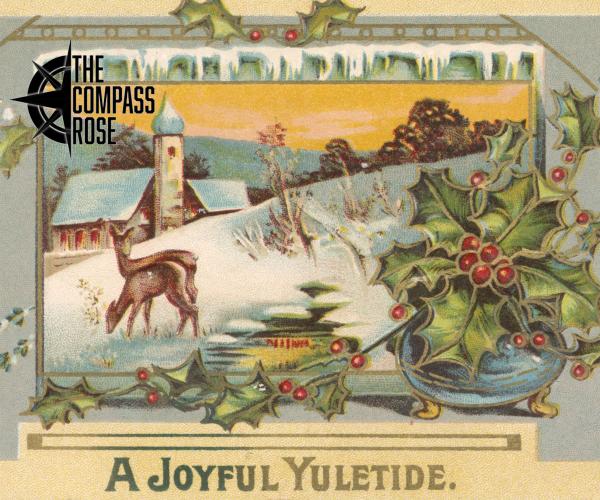
by Sara Pezzoni


by Sara Pezzoni
The purpose of The Compass Rose is to raise awareness of Special Collections' resources and to foster the use of these resources. The blog series also reports significant new programs, initiatives, and acquisitions of Special Collections.
This week, UTA Special Collections kicked off a new series on social media titled “12 Days of Holiday Greetings,” which is designed to highlight the diversity of our collection materials in regard to holiday correspondence! You can follow along on our Facebook page (facebook.com/Special-Collections-UTA-Library-159593908826) or on our Twitter page (twitter.com/spcouta).
The custom of sending greeting cards dates back to the ancient Chinese, who exchanged messages of goodwill to celebrate the New Year, and to the early Egyptians, who conveyed their greetings on papyrus scrolls. By the early 1400s, handmade paper greeting cards were being exchanged in Europe. The Germans are known to have printed New Year’s greetings from woodcuts as early as 1400, and handmade paper Valentines were being exchanged throughout Europe in the early to mid-1400s.
The first known published Christmas card appeared in London in 1843, when Sir Henry Cole commissioned artist John Calcott Horsley to design a holiday card featuring his family celebrating together that he could send to his friends and acquaintances. The card included a triptych illustrating a family at table celebrating the holiday, flanked by images of people engaged in acts of charity, with a message along the bottom that read "A Merry Christmas and a Happy New Year to You."
The Industrial Revolution led to advances in printing technology and mail service, which ultimately popularized the use of commercially produced greeting cards. Families were also beginning to spread out geographically and holiday cards served as a way of staying in touch with relatives. A growing importance of sentiment has also helped the tradition take root; from a psychological standpoint, greeting cards are widely understood to represent "a formal celebration of ideas of personal warmth and home feelings" and sending cards is not only a gesture of goodwill but also an act of expression for oneself (Brown, 2015).
In terms of greeting card messages, the phrases "Merry Christmas" and "Happy Holidays" both have religious origins and are derived from Old English. Christmas comes from “Cristes Maesse,” or the Mass of Christ, and the word “holiday,” comes from the medieval word “haliday” which is derived from Old English “haligdæg,” meaning “holy day.” However, the phrase “Happy Holidays” has become a more universal greeting over time, used to include people of various religions and a nod to the New Year (Pruitt, 2018). It’s clear that whatever your preferred message of greeting may be, wishing someone else well at this time of year (or any time, really) is never a bad idea.
In addition to the UTA Special Collections' small sampling of holiday greeting cards, some other examples of holiday greeting card collections come from the Smithsonian (including materials from the Archives of American Art, the Cooper Hewitt, and the National Museum of American History), the New York Public Library, the Newberry Library, the Hagley Museum and Library, and Loyola Marymount University. You can access these digital collections through the following links:
Newberry Library’s Curt Teich Postcard Archives digital collection
Hagley Digital Archives, Waldron Collection of Christmas and Holiday Postcards
Join UTA Special Collections on our Twitter and Facebook pages over the next several days to see more from our collection of holiday greeting cards! We here at UTA Libraries wish you and your family a wonderful holiday season!
--
Sources
Brown, Ellen F. Christmas, Inc.: A Brief History of the Holiday Card. JSTOR Daily, 2015.
Pruitt, Sarah. The War of Words behind ‘Happy Holidays.’ History.com, 2017.
The History of Greeting Cards. Greeting Card Association, undated.
Add new comment